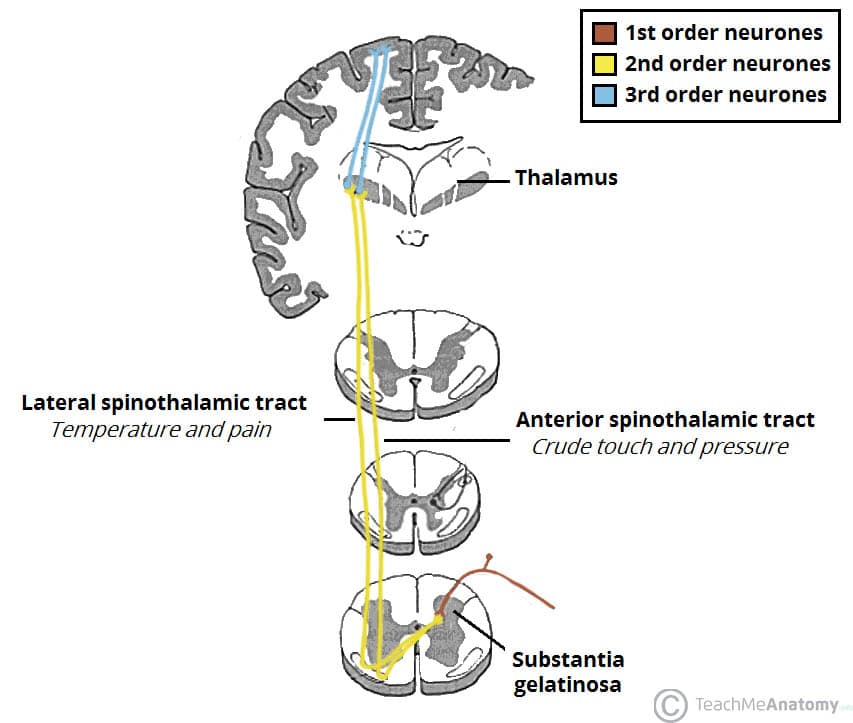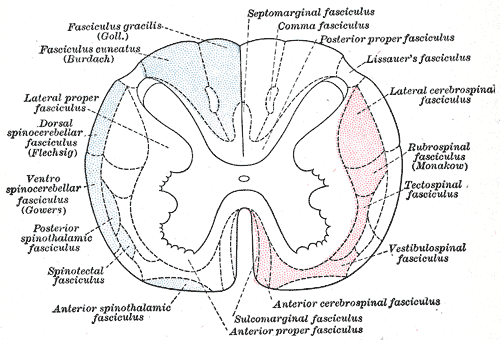- Somatosensation
- Exteroception via
- Cutaneous receptors + proprioception
- Interoception via
- Widely distributed receptors
- Specific and non-specific
- Exteroception via
2019-03-28 09:57:33
Prelude
Prelude
Today's Topics
- Wrap-up on somatosensation
- The neuroscience of action
Somatosensation

Functional segregation
- Dorsal column/medial leminiscal pathway
- Touch, proprioception
- Spinothalamic tract
- Pain, temperature
Somatatopic maps
Non-uniform mapping of skin surface
n
Non-uniform mapping of skin surface
Columnar organization/functional segregation
Phantom Limbs
What/where
- Perceiving Where
- Somatotopic maps – where on skin
- Kinesthesia – configuration of limbs
- Perceiving What
- Patterns of smoothness, roughness, shape, temperature
Somatosensation in other animals

Size/speed trade-off
The neuroscience of pain
- Nociceptors (Latin nocere to harm or hurt) detect harmful or potentially harmful stimuli of varied types:
- chemical
- mechanical
- thermal
Nociception
- External
- Skin, cornea (eye), mucosa
- Internal
- Muscles, joints, bladder, gut
Interoception
- Receptors for
- metabolism (acidic pH, hypoxia, …)
- cell rupture (ATP and glutamate)
- cutaneous parasite penetration (histamine)
- mast cell (white blood cell) activation (serotonin, bradykinin, …)
- immune and hormonal activity (cytokines and somatostatin)
Fast (\(A\delta\)) and slow (\(C\)) transmission to CNS
Projection to brain via anterolateral system

Key CNS nodes in network
- Periaqueductal grey (PAG) in midbrain
- Insular cortex (insula)
- Hypothalamus
- Amygdala
Key CNS nodes in network
- Thalamus
- Ventroposterior lateral nucleus
- Ventroposterior medial nucleus
- Ventromedial nucleus
Main points
Main points
- Pain
- Multiple receptor channels
- Highly interconnected CNS network
- Multiple targets for modulation
Action
The neuroscience of action
- What types of actions are there?
- How are they produced?
- By the muscles
- By the nervous system
Remember
- Nervous system "output" includes
- Movements
- Autonomic responses
- Endocrine responses
Types of actions
- Reflexes
- Simple, highly stereotyped, unlearned, rapid
- vs. Planned or voluntary actions
- Complex, flexible, acquired, slower
- Discrete (reaching) vs. rhythmic (walking)
- Ballistic (no feedback) vs. controlled (feedback)
Multiple, parallel controllers
Key "nodes" in network
- Primary motor cortex (M1)
- Non-primary motor cortex
- Basal ganglia
- Brain stem
- Cerebellum
- Spinal cord
Muscle classes
- Axial
- Trunk, neck, hips
- Proximal
- Shoulder/elbow, pelvis/knee
- Distal
- Hands/fingers, feet/toes
Muscles
Muscle types
- Smooth
- Arteries, hair follicles, uterus, intestines
- Regulated by ANS (involuntary)
- Striated (striped)
- Skeletal
- Voluntary control, mostly connected to tendons and bones
- Cardiac
Muscle types
How skeletal muscles contract
- Motoneuron (ventral horn of spinal cord)
- Neuromuscular junction
- Releases ACh
From spinal cord to muscle
How skeletal muscles contract
- Motor endplate
- Nicotinic ACh receptor
- Excitatory endplate potential
- Muscle fibers depolarize
- Depolarization spreads along fibers like an action potential
- Sarcomeres are segments of fibers
- Intramuscular stores release Ca++
Motor endplate
How skeletal muscles contract
- Myofibrils (w/in sarcomere)
- Actin & mysosin proteins
- “Molecular gears”
- Bind, move, unbind in presence of Ca++, ATP
Anatomy of muscle fibers
Anatomy of motor endplate
Muscle contraction
Agonist/antagonist muscle pairs
Meat preference?
Muscle fiber types
- Fast twitch/fatiguing
- Type II
- White meat
- Slow twitch/fatiguing
- Type I
- Red meat
Muscles are sensory organs, too!

Two muscle fiber types
Two muscle fiber types
- Intrafusal fibers
- Sense length/tension
- Contain muscle spindles linked to Ia afferents
- ennervated by gamma (\(\gamma\)) motor neurons
- Extrafusal fibers
- Generate force
- ennervated by alpha (\(\alpha\)) motor neurons
Monosynaptic stretch (myotatic) reflex
- Muscle stretched (length increases)
- Muscle spindle in intrafusal fiber activates
- Ia afferent sends signal to spinal cord
- Activates alpha (\(\alpha\)) motor neuron
- Muscle contracts, shortens length
Monosynaptic stetch (myotatic) reflex
- Gamma (\(\gamma\)) motor neuron fires to take up intrafusal fiber slack

Monosynaptic stretch (myotatic) reflex
Why doesn't antagonist muscle respond?
Why doesn't antagonist muscle respond?
- Polysynaptic inhibition of antagonist muscle
- Prevents/dampens tremor
Brain gets fast(est) sensory info from spindles
How the brain controls the muscles
- Pyramidal tracts
- Pyramidal cells (Cerebral Cortex Layer 5) in primary motor cortex (M1)
- Corticobulbar (cortex -> brainstem) tract
- Corticospinal (cortex -> spinal cord) tract
- Crossover (decussate) in medulla
- L side of brain ennervates R side of body
Corticospinal tract
How the brain controls the muscles
- Extrapyramidal system
- Tectospinal tract
- Vestibulospinal tract
- Reticulospinal tract
- Involuntary movements
- Posture, balance, arousal
Extrapyramidal system
This figure shows that the descending motor pathways in red on the right have their own spatial organization depending on where they originate in the brain.
Disorders
- Parkinson's
- Huntington's
The Faces of Parkinson's
Parkinson's
- Slow, absent movement, resting tremor
- Cognitive deficits, depression
- DA Neurons in substantia nigra degenerate
- Treatments
- DA agonists
- DA agonists linked to impulse control disorders in ~1/7 patients (Ramirez-Zamora et al. 2016)
- Levodopa (L-Dopa), DA precursor
Huntington's
Huntington's
- Formerly Huntington’s Chorea
- "Chorea" from Greek for "dance"
- “Dance-like” pattern of involuntary movements
- Cognitive decline
- Genetic + environmental influences
- Disturbance in striatum
- No effective treatment
Huntington's
Final thoughts
- Control of movement determined by multiple sources
- Cerebral cortex + basal ganglia + cerebellum + spinal circuits
Next time…
- Exam 3
References
Craig, A D. 2002. “How Do You Feel? Interoception: The Sense of the Physiological Condition of the Body.” Nat. Rev. Neurosci. 3 (8): 655–66. doi:10.1038/nrn894.
Ramirez-Zamora, Adolfo, Lucy Gee, James Boyd, and José Biller. 2016. “Treatment of Impulse Control Disorders in Parkinson’s Disease: Practical Considerations and Future Directions.” Expert Review of Neurotherapeutics 16 (4): 389–99. doi:10.1586/14737175.2016.1158103.






